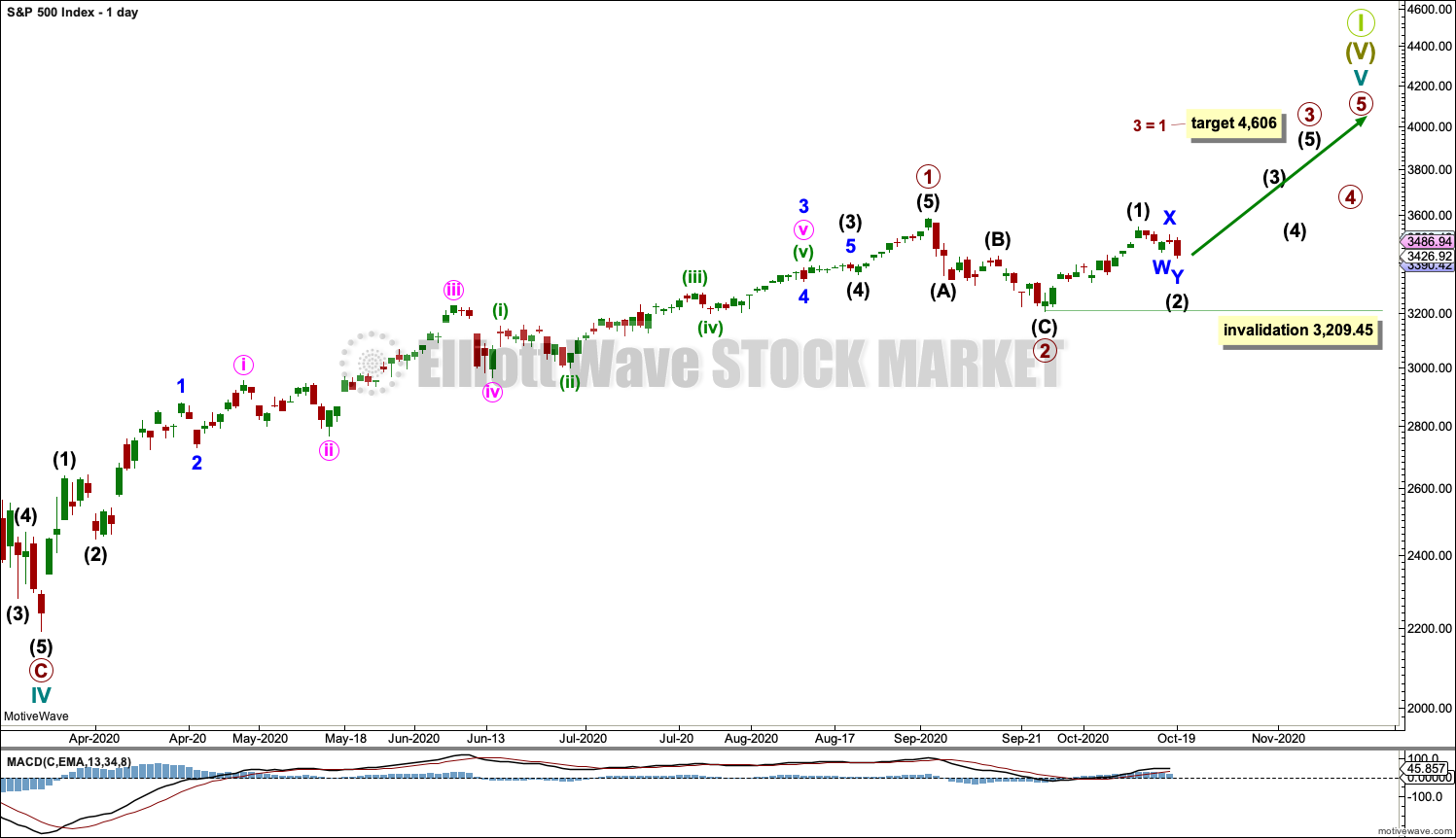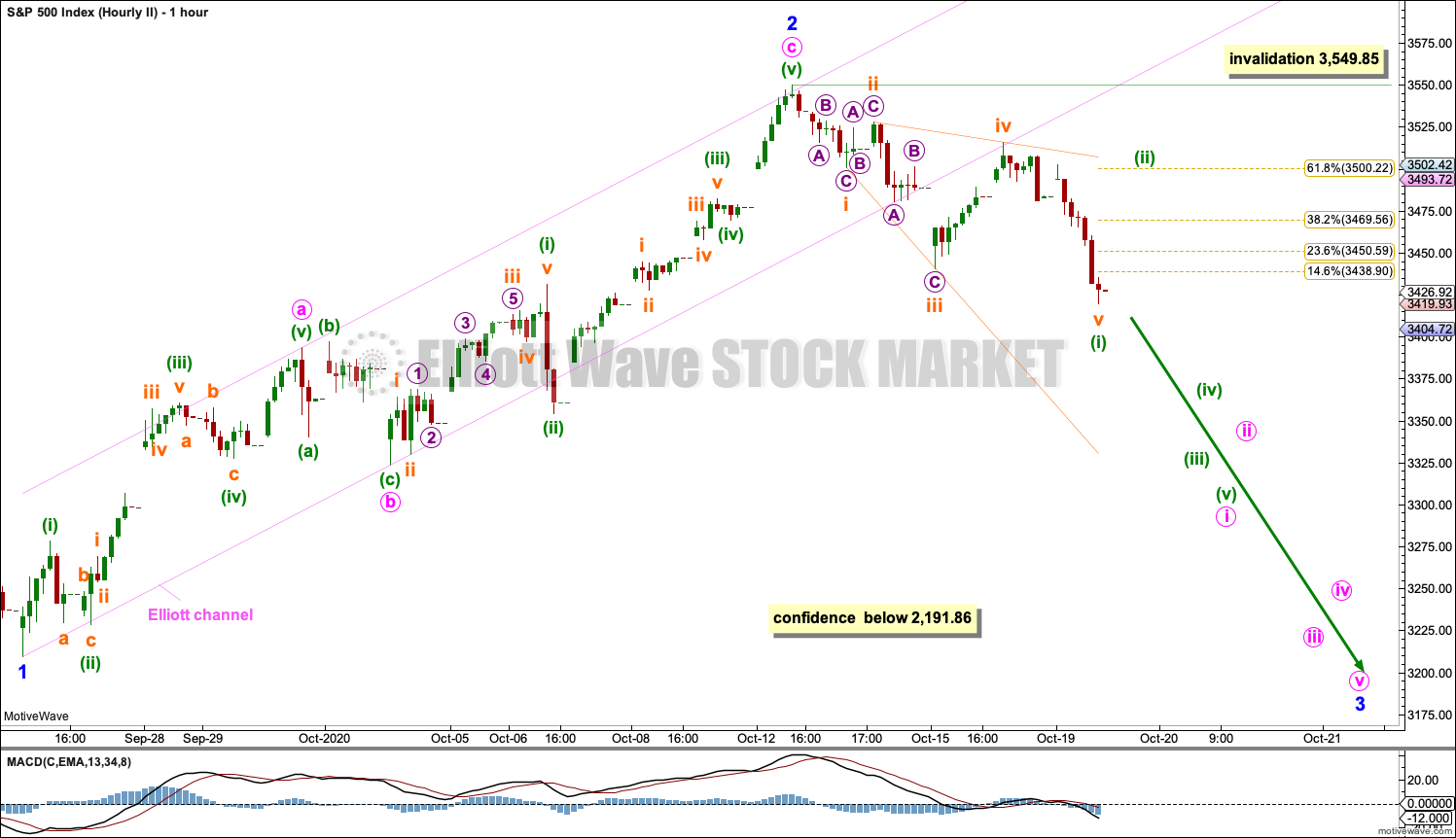S&P 500: Elliott Wave and Technical Analysis | Charts – October 19, 2020
Downwards movement to a short-term target at 3,418 was expected for the start of the new trading week. A strong downwards session reached 3,419.93, just 1.93 points short of the target.
Summary: The invalidation point is moved up to 3,209.45.
For the very short term, a very little more downwards movement may end tomorrow about 3,417 – 3,418. Thereafter, the upwards trend may resume.
The next target is at 4,606.
At this stage, a new high above 3,588.11 would invalidate the second very bearish Elliott wave count, leaving only a bullish Elliott wave count.
The biggest picture, Grand Super Cycle analysis, is here.
Monthly charts are here, with video here.
ELLIOTT WAVE COUNTS
FIRST WAVE COUNT
WEEKLY CHART
Cycle wave V may last from one to several years. So far it is in its seventh month.
Cycle wave V would most likely subdivide as an impulse. But if overlapping develops, then an ending diagonal should be considered. This chart considers the more common impulse.
Primary waves 1 and 2 may be complete.
Primary wave 3 may have begun. It may only subdivide as an impulse. Intermediate wave (2) within primary wave 3 may not move beyond the start of intermediate wave (1) below 3,209.45.
There is already a Fibonacci ratio between cycle waves I and III within Super Cycle wave (V). The S&P500 often exhibits a Fibonacci ratio between two of its actionary waves but rarely between all three; it is less likely that cycle wave V would exhibit a Fibonacci ratio. The target for Super Cycle wave (V) to end would best be calculated at primary degree, but that cannot be done until all of primary waves 1, 2, 3 and 4 are complete.
DAILY CHART
Primary waves 1 and 2 may both be complete. Primary wave 3 may now be underway.
Primary wave 3 may only subdivide as an impulse. Intermediate wave (2) within primary wave 3 may not move beyond the start of intermediate wave (1) below 3,209.45.
Primary wave 1 looks extended. The target for primary wave 3 expects it to also be extended.
Today two hourly charts remain. They are renamed main and alternate.
MAIN HOURLY CHART
It is possible that intermediate wave (1) within primary wave 3 may be over.
Intermediate wave (2) may continue a little lower as a double combination: zigzag – X – expanded flat. The target for intermediate wave (2) is expanded to a small zone calculated at two degrees.
Intermediate wave (2) may not move beyond the start of intermediate wave (1) below 3,209.45.
ALTERNATE HOURLY CHART
It is also possible that intermediate wave (1) may be incomplete. This wave count no longer has the best look in Elliott wave terms because minor waves 4 and 2 no longer have good proportion.
The channel about intermediate wave (1) is redrawn using Elliott’s second technique: draw the first trend line from the ends of minor waves 2 to 4, then place a parallel copy on the end of minor wave 3. Minor wave 5 may end mid way within the channel. The target for minor wave 5 expects it to exhibit the most common Fibonacci ratio for a fifth wave.
Minor wave 4 may not move into minor wave 1 price territory below 3,393.56.
SECOND WAVE COUNT
DAILY CHART
This wave count is the same as the first wave count with the exception of the degree of labelling within cycle wave V. If the degree of labelling is moved up one degree, then it is possible that cycle wave V to end Super cycle wave (V) to end Grand Super Cycle wave I is complete.
A new low below 2,191.86 would add confidence in this wave count. At that stage, the first wave count would be invalidated.
A new bear market at Grand Super Cycle degree may be expected to last over a decade. It may take price below the start of Super Cycle wave (V) at 666.79 in March 2009.
A first five down, labelled minor wave 1, may be complete. Minor wave 2 now also may be complete. A third wave down at minor degree may just have begun. It should exhibit strength if this wave count is correct. So far it has not. This wave count does not have support from technical analysis.
Major new downwards trends for this market usually begin with strength. The lack of any 90% down days or back to back 80% down days reduces the probability of this wave count. Now with the AD line making a new all time high and two back to back 80% upwards days the probability of this wave count has reduced further.
HOURLY CHART
Minor wave 2 may be a complete zigzag.
If it continues higher as a double zigzag, then minor wave 2 may not move beyond the start of minor wave 1 above 3,588.11.
Minor wave 3 downwards may have begun. Minuette wave (i) within minute wave i within minor wave 3 may be a complete leading expanding diagonal. This structure is not very common, so the probability of this wave count is further reduced.
If this wave count is correct, then following a leading diagonal in a first wave position should be a deep second wave correction. Minuette wave (ii) may be at least 0.618 of minuette wave (i) and possibly deeper. If minuette wave (i) moves lower, then the Fibonacci retracement must be adjusted.
TECHNICAL ANALYSIS
WEEKLY CHART
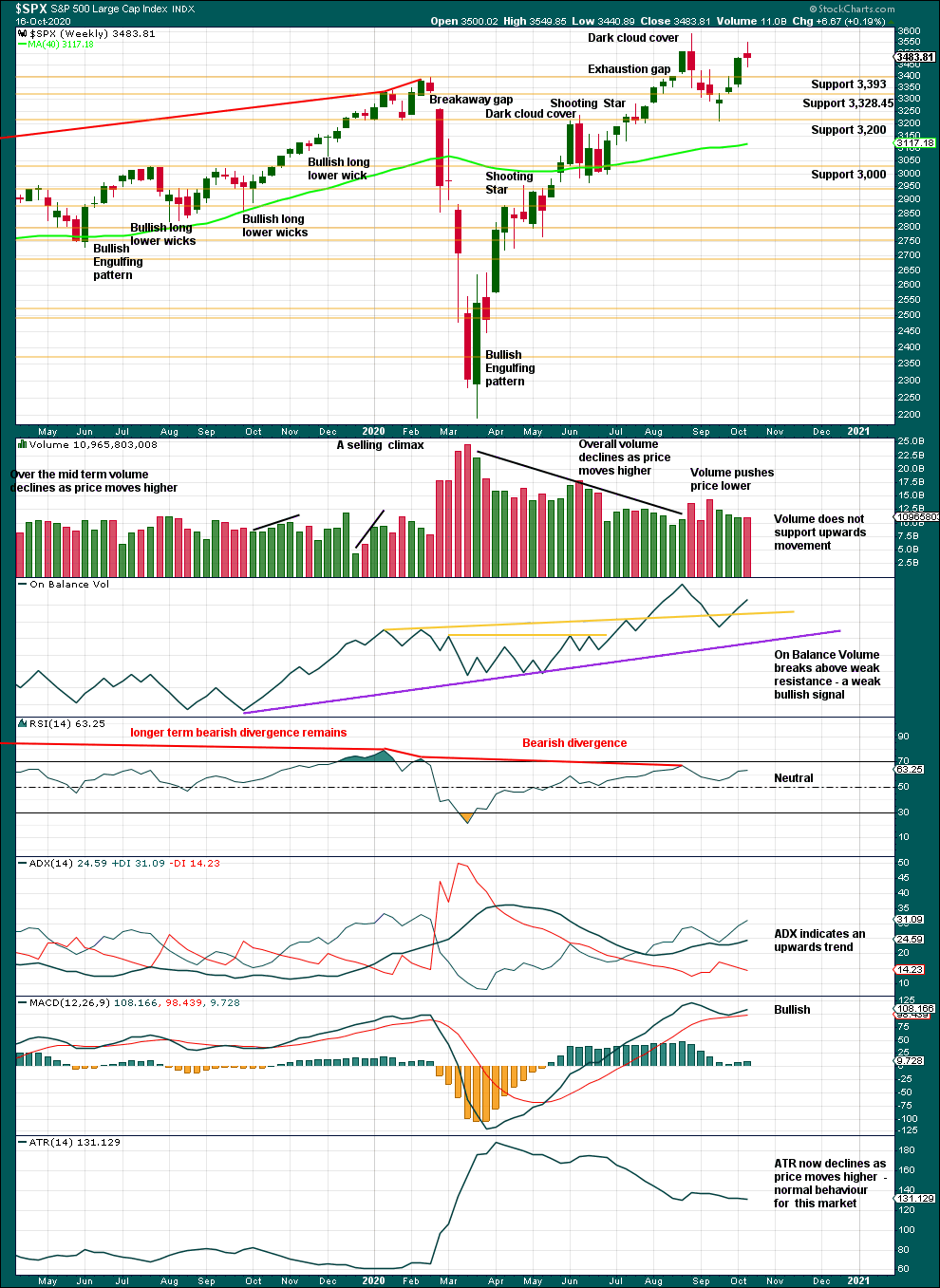
Click chart to enlarge. Chart courtesy of StockCharts.com.
Last week closes as a red doji. A doji on its own represents a pause and may occur within an upwards trend; it is on its own not a bearish reversal pattern.
There is an upwards trend in place.
DAILY CHART
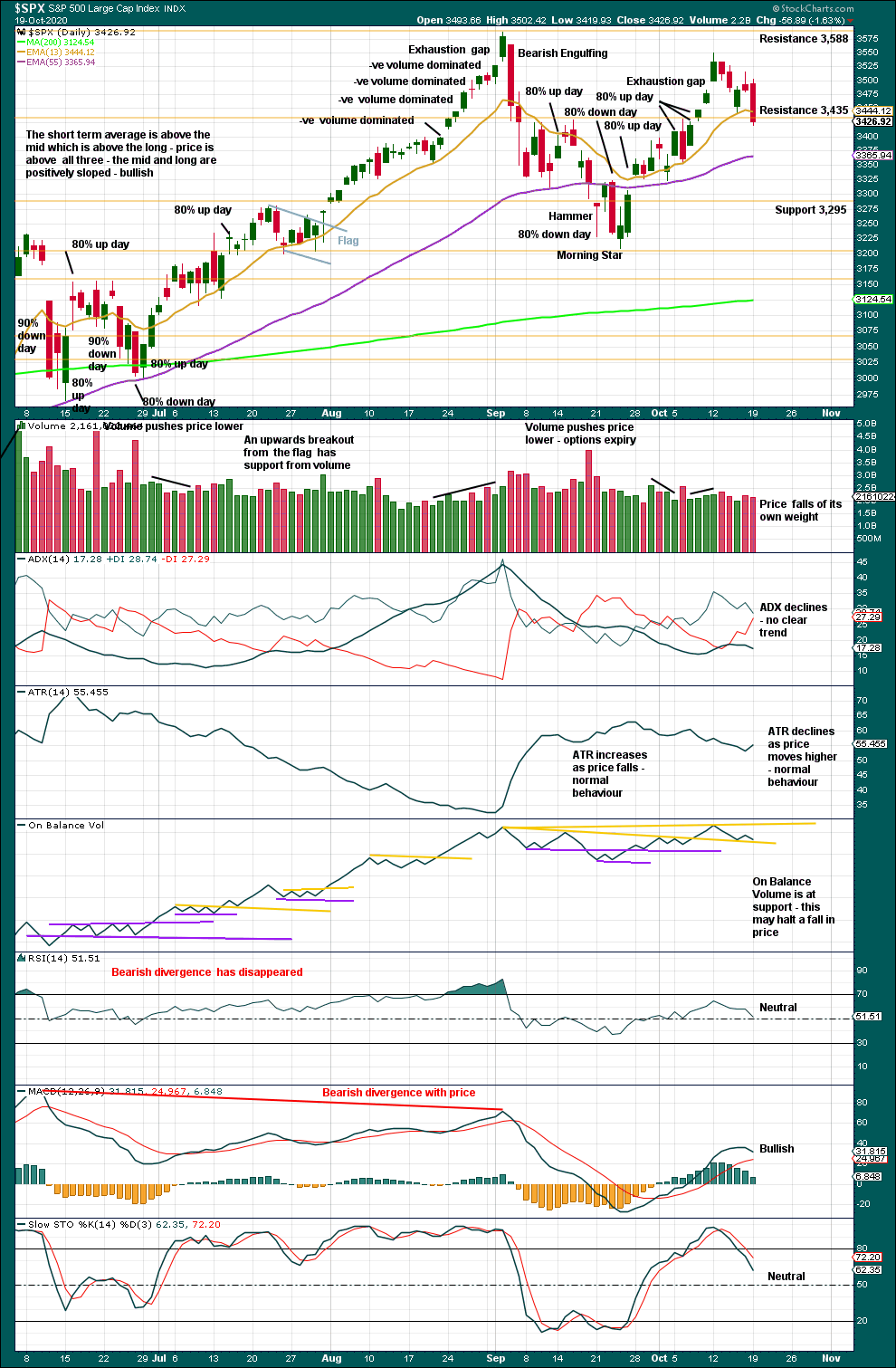
Click chart to enlarge. Chart courtesy of StockCharts.com.
There are now two back to back 80% upwards days.
All of On Balance Volume, ADX and MACD are bullish. There is an upwards trend in place.
A lack of volume today and On Balance Volume at support suggest the fall in price may end here or very soon tomorrow.
BREADTH – AD LINE
WEEKLY CHART
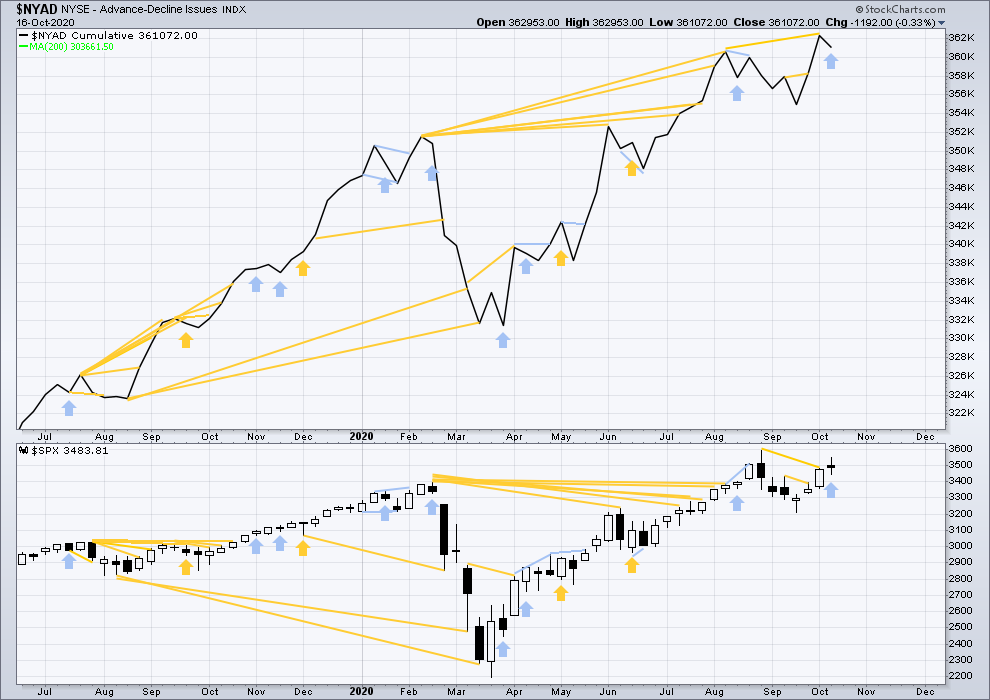
Click chart to enlarge. Chart courtesy of StockCharts.com. So that colour blind members are included, bearish signals will be noted with blue and bullish signals with yellow.
Breadth should be read as a leading indicator.
Lowry’s Operating Companies Only AD line has made a new all time high on the 12th of October. This erases prior bearish divergence with the last all time high in January 2020. With both the NYSE and OCO AD lines making new all time highs, breadth is leading price. This is a strong bullish signal and supports the first Elliott wave count. The second bearish Elliott wave count may be discarded this week if price continues higher.
Large caps all time high: 3,588.11 on September 2, 2020.
Mid caps all time high: 2,109.43 on February 20, 2020.
Small caps all time high: 1,100.58 on August 27, 2018.
This rise has been led by large caps, which is a feature of an aged bull market. Above the swing high of the 11th of August, large caps first made a new high now followed by mid caps. Small caps have not yet made a new high above this point.
DAILY CHART
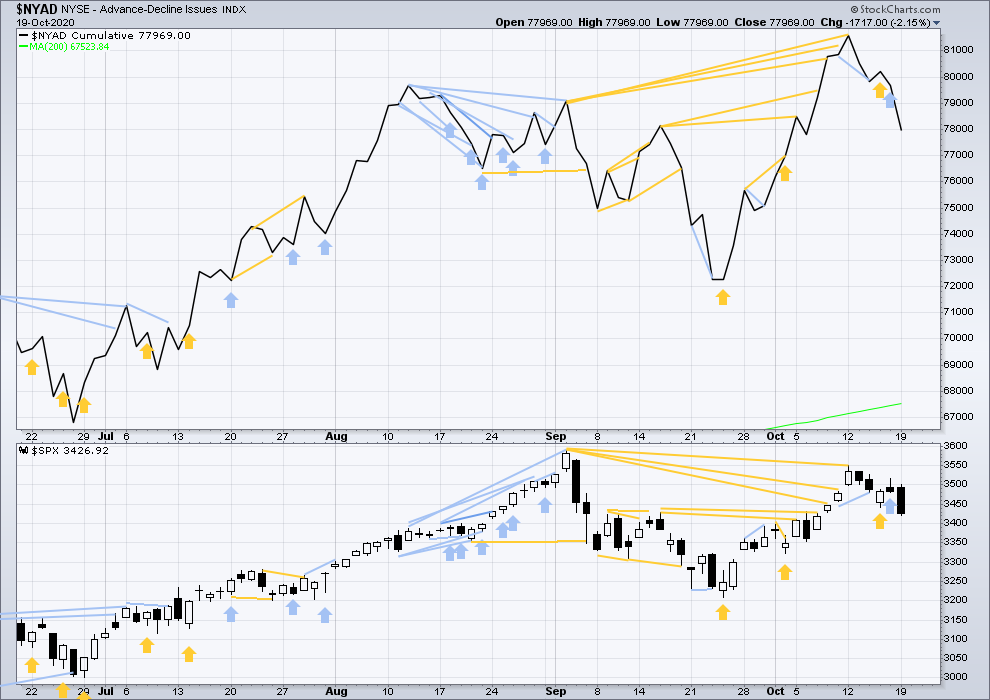
Click chart to enlarge. Chart courtesy of StockCharts.com. So that colour blind members are included, bearish signals will be noted with blue and bullish signals with yellow.
Bearish divergence noted in last analysis has now been followed by downwards movement, so it may now be resolved.
Today both price and the AD line have moved lower. Neither has made new short-term swing lows. There is no new divergence.
VOLATILITY – INVERTED VIX CHART
WEEKLY CHART

Click chart to enlarge. Chart courtesy of StockCharts.com. So that colour blind members are included, bearish signals will be noted with blue and bullish signals with yellow.
Inverted VIX remains well below all time highs. The all time high for inverted VIX was in the week beginning October 30, 2017. There is nearly 3 years of bearish divergence between price and inverted VIX. There is all of long, mid and short-term bearish divergence.
Last week price has moved higher, but inverted VIX has moved lower. This divergence is bearish for the short term.
Comparing VIX and VVIX: Last week both VIX and VVIX have moved higher. There is no new short-term divergence.
DAILY CHART
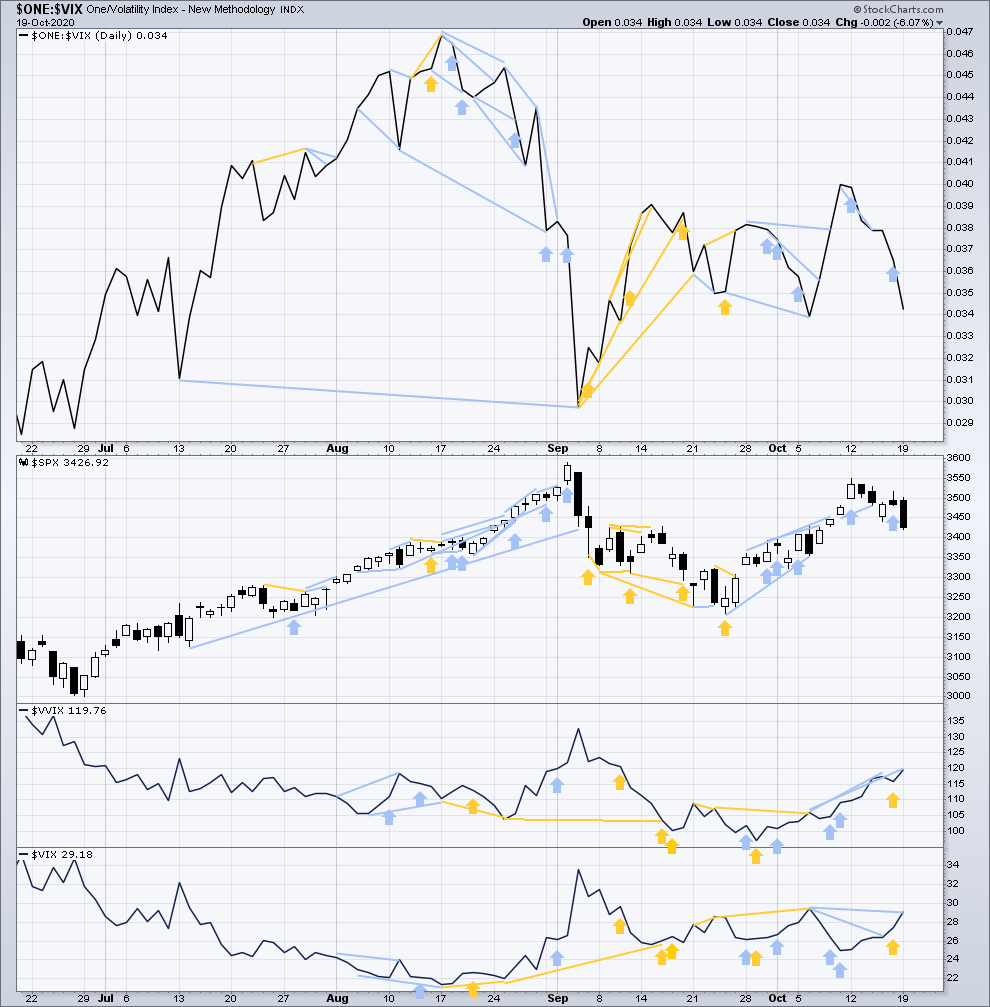
Click chart to enlarge. Chart courtesy of StockCharts.com. So that colour blind members are included, bearish signals will be noted with blue and bullish signals with yellow.
Short-term bearish divergence has now been followed by downwards movement, so it may now be resolved.
Today both price and inverted VIX have moved lower. There is no new short-term divergence.
Comparing VIX and VVIX at the daily chart level: VVIX has made a new short-term swing high above the prior high of the 6th of October, but VIX has not. This divergence is bearish for price.
DOW THEORY
Dow Theory still concludes a bear market is in place.
Dow Theory confirmed a bear market with the following lows made on a closing basis:
DJIA: 21,712.53 – a close below this point was been made on the March 12, 2020.
DJT: 8,636.79 – a close below this point was been made on March 9, 2020.
Adding in the S&P and Nasdaq for an extended Dow Theory, a bear market was confirmed:
S&P500: 2,346.58 – a close below this point was made on March 20, 2020.
Nasdaq: 7,292.22 – a close below this point was made on the March 12, 2020.
At this time, to shift Dow Theory from viewing a bear market to confirmation of a new bull market would require new highs made on a closing basis:
DJIA: 29,568.57
DJT: 11,623.58 – closed above on 7th October 2020.
Adding in the S&P and Nasdaq for an extended Dow Theory, confirmation of a bull market would require new highs made on a closing basis:
S&P500: 3,393.52 – closed above on 21st August 2020.
Nasdaq: 9,838.37 – closed above on June 8, 2020.
Published @ 06:17 p.m. ET.
—
Careful risk management protects your trading account(s).
Follow my two Golden Rules:
1. Always trade with stops.
2. Risk only 1-5% of equity on any one trade.
—
New updates to this analysis are in bold.


